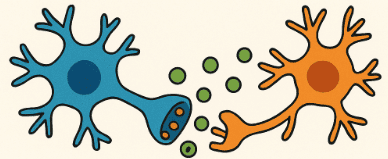
🔄 Recap of Lesson 3
Last time, in Lesson 3, we learned how neurons use electricity to send signals. We saw that:
-
A resting neuron is like a spring pressed down, full of potential energy.
-
When triggered, sodium and potassium ions move in and out, creating a tiny spark.
-
This spark (the action potential) runs down the axon, like a wave rolling through a crowd.
-
Myelin sheaths speed things up by letting signals “jump” along nodes.
-
Neurons follow the “all-or-none” rule—either they fire completely, or they don’t fire at all.
But here’s the question: If electricity runs down the axon, how does the message jump from one neuron to the next? After all, neurons don’t actually touch each other. 🤔
That’s where chemicals come in.
🕸️ Step 1: What is a Synapse?
Between one neuron and the next, there is a tiny space. This space is called a synapse.
Imagine two kids on opposite sides of a small river 🌊. One child can’t directly hand the ball to the other because the river is in the way. Instead, the child throws the ball across the river, and the other catches it.
In the same way:
-
The axon terminal of one neuron “throws” a chemical message.
-
The dendrite of the next neuron “catches” it.
That little space in between is the synapse.
🌈 Step 2: What are Neurotransmitters?
The “balls” that neurons throw across the synapse are called neurotransmitters.
Neurotransmitters are special chemicals that act like messengers. They carry the signal from one neuron to the next.
When the action potential reaches the end of the axon (axon terminal), it opens tiny packages called vesicles. These vesicles release neurotransmitters into the synapse.
The neurotransmitters then float across and attach to the next neuron’s dendrites, starting a new action potential.
So, neurotransmitters are like keys, and the dendrites have locks (called receptors). If the key fits, the lock opens, and the message continues.
🎭 Step 3: Different Types of Neurotransmitters
There are many types of neurotransmitters, each with its own special job. Let’s meet some of the most important ones:
-
Dopamine 🎮 – Helps with movement, learning, motivation, and reward. It’s the “feel-good” chemical when you accomplish something.
-
Serotonin 🌞 – Helps with mood, sleep, and feeling calm. Low serotonin can make people feel sad or anxious.
-
Acetylcholine (ACh) ⚡ – Helps muscles contract and also supports memory and learning.
-
GABA 🛑 – Slows things down, calming the brain and reducing over-excitement.
-
Glutamate 🚀 – Speeds things up, exciting neurons to fire. Important for learning and memory.
-
Endorphins 🏃♂️ – Natural painkillers released during exercise, laughter, or even eating chocolate 🍫.
⚖️ Step 4: Balance is Key
Just like too much sugar or too little water can cause problems, the brain needs the right balance of neurotransmitters.
-
Too little dopamine → movement problems (like Parkinson’s disease).
-
Too much dopamine → overstimulation (can happen in schizophrenia).
-
Too little serotonin → sadness or depression.
-
Too little acetylcholine → memory loss (as in Alzheimer’s disease).
So, neurotransmitters are like spices in cooking. 🍲 Too much or too little, and the recipe doesn’t work.
🎵 Step 5: Everyday Examples
-
When you laugh so hard your stomach hurts, endorphins are working.
-
When you study and remember facts, glutamate and acetylcholine are active.
-
When you feel butterflies in your stomach before an exam, serotonin is at play.
-
When you run and feel a “runner’s high,” that’s endorphins again.
Your thoughts, feelings, and actions are all colored by these tiny chemical artists painting inside your brain. 🎨
🧠 Fun Fact
Did you know? A single neuron can release more than one neurotransmitter. It’s like a musician playing more than one instrument 🎺🎹 to create harmony.
📝 Recap of Lesson 4
-
Neurons don’t touch each other—they are separated by a tiny gap called a synapse.
-
Neurotransmitters are chemical messengers that jump across the gap.
-
They act like keys fitting into locks on the next neuron.
-
Different neurotransmitters have different jobs: dopamine (reward), serotonin (mood), acetylcholine (movement), GABA (calm), glutamate (excitement), endorphins (pain relief).
-
The right balance of neurotransmitters keeps the brain and body healthy.